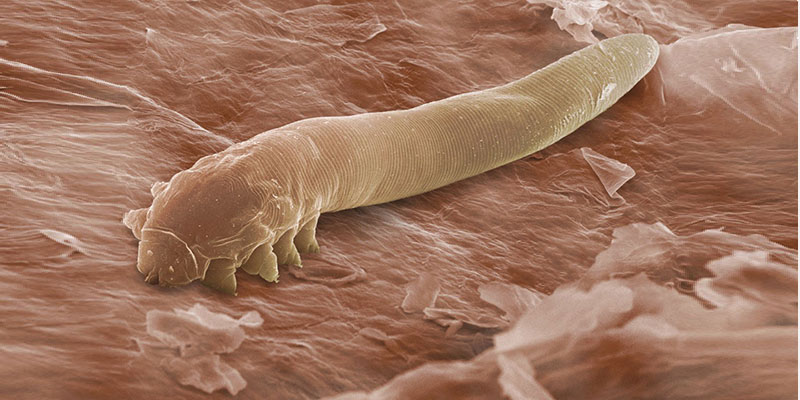Eyelash mites – the very idea of them probably grosses you out. I mean, who wants to think there are microscopic bugs living in the skin on their face. Eyelash mites are quite common though.
Did you know that there are actually two different species of mites that live on humans? Though similar, Demodex brevis and Demodex folliculorum have slightly different behaviors and biologies. This means the way they cause problems, and the way they are treated, are also a bit different.
In this article, we are going to take an in-depth look at the D. brevis species.
The Biology of Demodex Brevis
As with other species of Demodex mites, D. brevis is too small to be seen by the naked eye and is only visible under a microscope.
D. brevis is the smaller of the two species of Demodex mites that inhabit humans, measuring only 0.2mm (0.008 inches) in length. This species of Demodex mite is found all over the body, including the face, though it is not as common on facial skin as D. folliculorum.
The preferred home of the D. brevis species is sebaceous (oil) glands. These mites spend most of their lives deep inside glands and pores, where they eat oil and skin cells.1
Are These Mites Causing My Skin/eye Problems?
Demodex brevis mites are fairly common, but usually, don’t cause any symptoms. However, if they become overpopulated they can trigger inflammation, causing a few skins and eye issues.
Indications for D. brevis include acne2 and chalazia3 or blepharitis– swelling in the eyelid that stems from blocked glands. This can lead to related disorders like dermatitis, dry eye disease, and conjunctivitis (pink eye).4,5
If you are experiencing symptoms such as blurry vision, light sensitivity, or red, itching, sore, or stinging eyes, eyelids, or facial skin, you might want to have your eye doctor check for Demodex mites.6
What Do I Get Rid of Demodex Brevis Mites?
There are a few quick remedies you can use to manage symptoms caused by D. brevis.
- Lubricating eye drops like artificial tears can relieve symptoms of dry eye.
- Topical corticosteroids, such as hydrocortisone, can help reduce inflammation on your skin and eyelids.7
Fully clearing a Demodex infestation can be a little more difficult. Since the mites live inside oil glands and have a life cycle that lasts several weeks, therapies must continue long enough to completely eliminate all mites and their eggs after they hatch.
If an infestation is severe enough, your doctor may prescribe oral or topical antiparasitic medications such as ivermectin or tetracycline.8 These drugs can come with some unpleasant side effects, however.
For a safer, natural approach, Cliradex towelettes are a good option. Cliradex towelettes contain 4-terpineol, an important ingredient in tea tree oil. 4-terpineol has been shown in studies to be effective in killing Demodex mites.9 4-terpineol is also gentle enough to use for the length of time needed to eliminate a Demodex infestation.
How Can I Prevent a Demodex Brevis Infestation?
The simple answer is hygiene: keeping your face and eyes clean will help prevent mites from becoming established, and will clear irritants and other factors that can cause an infestation to get out of control.
Cliradex Light foaming cleanser was designed with this goal in mind. Its plant-based ingredients are gentle enough to use long-term as a part of your daily facial cleansing routine.
With Cliradex, Demodex infestations are no longer a worry.
References:
1. Rather PA, Hassan I. Human demodex mite: the versatile mite of dermatological importance. Indian journal of dermatology. 2014;59(1):60-66.
2. Roihu T, Kariniemi AL. Demodex mites in acne rosacea. Journal of cutaneous pathology. 1998;25(10):550-552.
3. Liang L, Ding X, Tseng SC. High prevalence of demodex brevis infestation in chalazia. American journal of ophthalmology. 2014;157(2):342-348.e341.
4. Liu J, Sheha H, Tseng SC. Pathogenic role of Demodex mites in blepharitis. Current opinion in allergy and clinical immunology. 2010;10(5):505-510.
5. Cheng AM, Sheha H, Tseng SC. Recent advances on ocular Demodex infestation. Current opinion in ophthalmology. 2015;26(4):295-300.
6. Kosik-Bogacka DI, Lanocha N, Lanocha A, et al. Role of Demodex folliculorum in the pathogenesis of blepharitis. Acta ophthalmologica. 2012;90(7):e579.
7. Benitez-Del-Castillo JM. How to promote and preserve eyelid health. Clinical ophthalmology (Auckland, NZ). 2012;6:1689-1698.
8. Kheirkhah A, Casas V, Li W, Raju VK, Tseng SC. Corneal manifestations of ocular demodex infestation. American journal of ophthalmology. 2007;143(5):743-749.
9. Tighe S, Gao YY, Tseng SC. Terpinen-4-ol is the Most Active Ingredient of Tea Tree Oil to Kill Demodex Mites. Translational vision science & technology. 2013;2(7):2.




